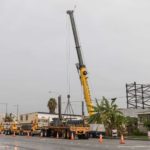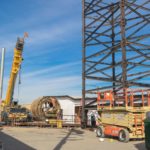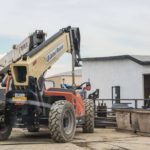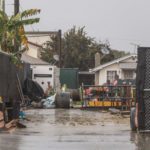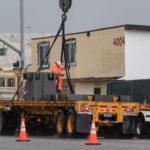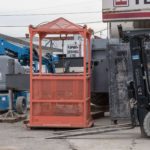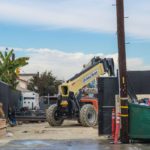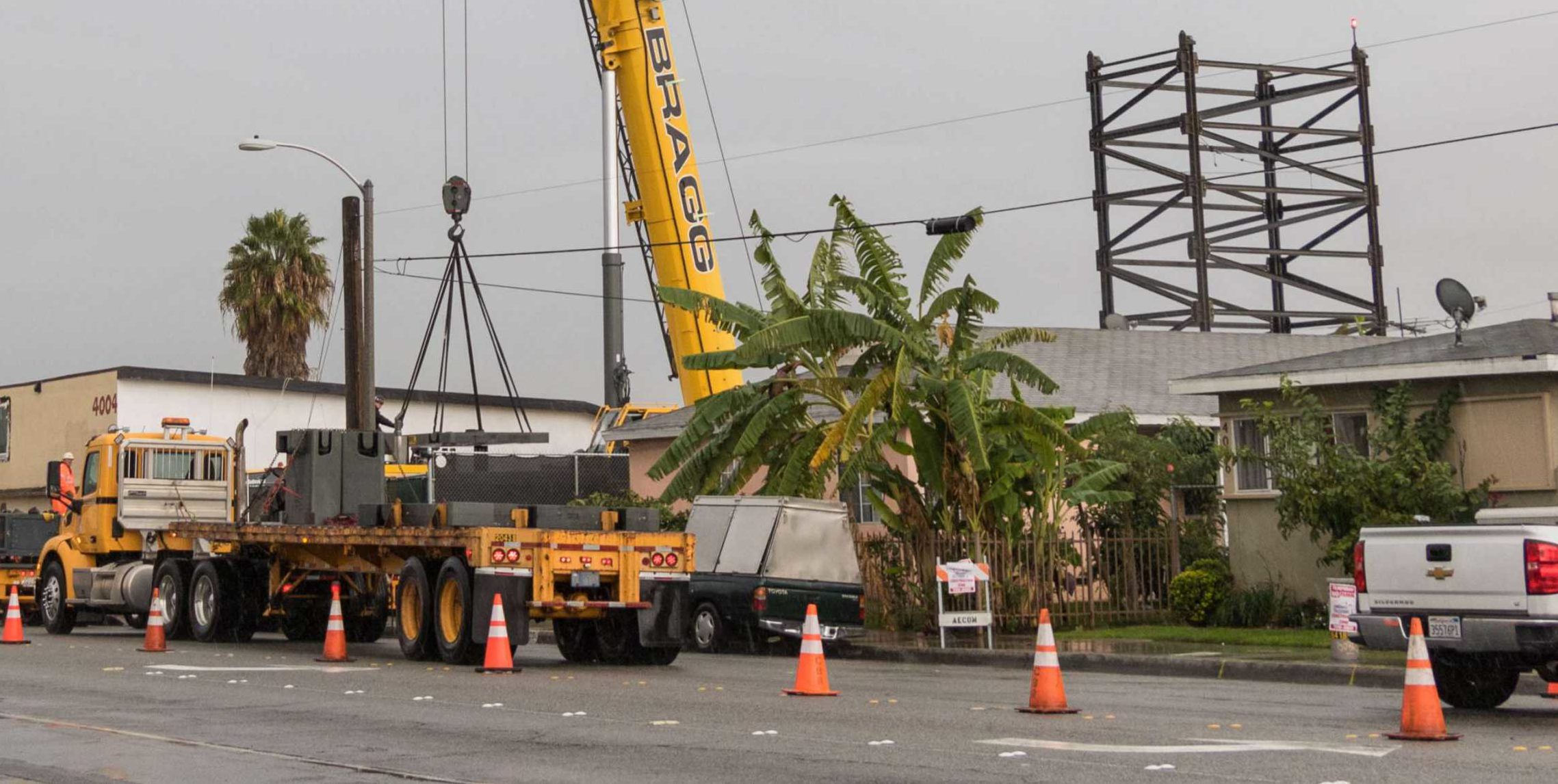
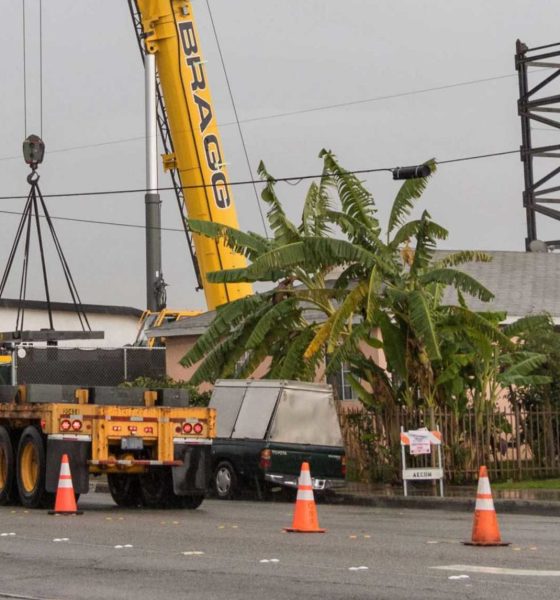
News
The Boring Company’s garage-elevator site takes shape ahead of Dec 18 tunnel opening
The Boring Company continues to make progress on the garage elevator prototype in its Prairie Avenue work site, located roughly at the halfway point of the tunneling startup’s 2-mile test tunnel in Hawthorne, CA. As the days trickle down towards the test tunnel’s unveiling on December 18, The Boring Co. appears to be digging deep in order to ensure that its projects in the area are making good progress.
On the site of the tunneling startup’s garage-elevator prototype, work continued despite last week’s rains. Teslarati photographer Pauline Acalin was in the area last Thursday, and she was able to snap some pictures of workers near the site. Returning to the elevator’s location this Monday, it was evident that work progressed, as evidenced by the disappearance of a massive structure previously set up beside the garage-elevator’s pit.
- The Boring Company’s garage-elevator site as of 12/06/2018. (Credit: Pauline Acalin)
- A structure believed to be an elevator shaft was built beside the opening of the Prairie Ave. garage-elevator site. (Credit: Pauline Acalin)
- A structure believed to be an elevator shaft was built beside the opening of the Prairie Ave. garage-elevator site. (Credit: Pauline Acalin)
- The Boring Company’s garage-elevator site as of 12/10/2018. (Credit: Pauline Acalin)
A massive structure believed to be an elevator shaft is believed to have been installed in the garage-elevator as of 12/10/2018. (Credit: Pauline Acalin)
Images taken near the end of November showed a massive structure being set up by The Boring Company beside the pit where it extracted the segments of Godot, its first tunnel boring machine. While the Boring Company did not identify or confirm the purpose of the structure, its size and height suggested that it was a shaft for the underground elevator being built on the site, where vehicles will be lifted out from the test tunnel.
Considering that the elevator shaft was nowhere to be seen as of Monday, it appears safe to assume that the structure has already been installed in the elevator itself. This bodes well for the project, as the structure is a key component to the Boring Company’s plans in the area. The garage-elevator, after all, is a bit different from the tunneling startup’s other projects, such the Hawthorne tunnel or the Dugout Loop, in the way that it would not be opened to the public even when it gets completed.
Instead, the structure would be used strictly for testing purposes only, with vehicles being moved from the test tunnel into the elevator, before being lifted onto the street. In a statement to Mercury News last September, Boring Company representative Jane Labanowski described the garage-elevator as an “important part of the longer-term vision the company is trying to build.” If the garage-elevator works as intended, it is not difficult to imagine The Boring Company rolling out the concept to its future stations, particularly those located near or even within residential areas.
- The Boring Company’s garage-elevator site as of 12/06/2018. (Credit: Pauline Acalin)
- The Boring Company’s garage-elevator site as of 12/06/2018. (Credit: Pauline Acalin)
- The Boring Company’s garage-elevator site as of 12/06/2018. (Credit: Pauline Acalin)
- The Boring Company’s garage-elevator site as of 12/06/2018. (Credit: Pauline Acalin)
- The Boring Company’s garage-elevator site as of 12/06/2018. (Credit: Pauline Acalin)
- The Boring Company’s garage-elevator site as of 12/10/2018. (Credit: Pauline Acalin)
- The Boring Company’s garage-elevator site as of 12/10/2018. (Credit: Pauline Acalin)
Work continues on the site of The Boring Company’s garage-elevator concept. (Credit: Pauline Acalin)
Similar to The Boring Company’s other projects, the vehicles that would be transported from the SpaceX headquarters to the elevator will be traveling through the startup’s electric skates. These skates use Hyperloop technology, and are expected to facilitate high-speed transportation from the tunnels to the garage-elevator.
The Boring Company initially announced that it would hold an opening party for its Hawthorne test tunnel on December 10, with test rides in the system being offered to the public for free the following day. In a recent announcement, though, Elon Musk stated that the test tunnel’s opening event is being moved to December 18 instead. Musk did not give a specific reason behind the delay, though considering the work still being done on some Boring Company projects like the Prairie Avenue elevator, there is a good chance that the tunneling startup is opting to refine some of its projects further before unveiling them to the public.

Elon Musk
Elon Musk and Tesla AI Director share insights after empty driver seat Robotaxi rides
The executives’ unoccupied tests hint at the rapid progress of Tesla’s unsupervised Robotaxi efforts.

Tesla CEO Elon Musk and AI Director Ashok Elluswamy celebrated Christmas Eve by sharing personal experiences with Robotaxi vehicles that had no safety monitor or occupant in the driver’s seat. Musk described the system’s “perfect driving” around Austin, while Elluswamy posted video from the back seat, calling it “an amazing experience.”
The executives’ unoccupied tests hint at the rapid progress of Tesla’s unsupervised Robotaxi efforts.
Elon and Ashok’s firsthand Robotaxi insights
Prior to Musk and the Tesla AI Director’s posts, sightings of unmanned Teslas navigating public roads were widely shared on social media. One such vehicle was spotted in Austin, Texas, which Elon Musk acknowleged by stating that “Testing is underway with no occupants in the car.”
Based on his Christmas Eve post, Musk seemed to have tested an unmanned Tesla himself. “A Tesla with no safety monitor in the car and me sitting in the passenger seat took me all around Austin on Sunday with perfect driving,” Musk wrote in his post.
Elluswamy responded with a 2-minute video showing himself in the rear of an unmanned Tesla. The video featured the vehicle’s empty front seats, as well as its smooth handling through real-world traffic. He captioned his video with the words, “It’s an amazing experience!”
Towards Unsupervised operations
During an xAI Hackathon earlier this month, Elon Musk mentioned that Tesla owed be removing Safety Monitors from its Robotaxis in Austin in just three weeks. “Unsupervised is pretty much solved at this point. So there will be Tesla Robotaxis operating in Austin with no one in them. Not even anyone in the passenger seat in about three weeks,” he said. Musk echoed similar estimates at the 2025 Annual Shareholder Meeting and the Q3 2025 earnings call.
Considering the insights that were posted Musk and Elluswamy, it does appear that Tesla is working hard towards operating its Robotaxis with no safety monitors. This is quite impressive considering that the service was launched just earlier this year.
Elon Musk
Starlink passes 9 million active customers just weeks after hitting 8 million
The milestone highlights the accelerating growth of Starlink, which has now been adding over 20,000 new users per day.

SpaceX’s Starlink satellite internet service has continued its rapid global expansion, surpassing 9 million active customers just weeks after crossing the 8 million mark.
The milestone highlights the accelerating growth of Starlink, which has now been adding over 20,000 new users per day.
9 million customers
In a post on X, SpaceX stated that Starlink now serves over 9 million active users across 155 countries, territories, and markets. The company reached 8 million customers in early November, meaning it added roughly 1 million subscribers in under seven weeks, or about 21,275 new users on average per day.
“Starlink is connecting more than 9M active customers with high-speed internet across 155 countries, territories, and many other markets,” Starlink wrote in a post on its official X account. SpaceX President Gwynne Shotwell also celebrated the milestone on X. “A huge thank you to all of our customers and congrats to the Starlink team for such an incredible product,” she wrote.
That growth rate reflects both rising demand for broadband in underserved regions and Starlink’s expanding satellite constellation, which now includes more than 9,000 low-Earth-orbit satellites designed to deliver high-speed, low-latency internet worldwide.
Starlink’s momentum
Starlink’s momentum has been building up. SpaceX reported 4.6 million Starlink customers in December 2024, followed by 7 million by August 2025, and 8 million customers in November. Independent data also suggests Starlink usage is rising sharply, with Cloudflare reporting that global web traffic from Starlink users more than doubled in 2025, as noted in an Insider report.
Starlink’s momentum is increasingly tied to SpaceX’s broader financial outlook. Elon Musk has said the satellite network is “by far” the company’s largest revenue driver, and reports suggest SpaceX may be positioning itself for an initial public offering as soon as next year, with valuations estimated as high as $1.5 trillion. Musk has also suggested in the past that Starlink could have its own IPO in the future.
News
NVIDIA Director of Robotics: Tesla FSD v14 is the first AI to pass the “Physical Turing Test”
After testing FSD v14, Fan stated that his experience with FSD felt magical at first, but it soon started to feel like a routine.

NVIDIA Director of Robotics Jim Fan has praised Tesla’s Full Self-Driving (Supervised) v14 as the first AI to pass what he described as a “Physical Turing Test.”
After testing FSD v14, Fan stated that his experience with FSD felt magical at first, but it soon started to feel like a routine. And just like smartphones today, removing it now would “actively hurt.”
Jim Fan’s hands-on FSD v14 impressions
Fan, a leading researcher in embodied AI who is currently solving Physical AI at NVIDIA and spearheading the company’s Project GR00T initiative, noted that he actually was late to the Tesla game. He was, however, one of the first to try out FSD v14.
“I was very late to own a Tesla but among the earliest to try out FSD v14. It’s perhaps the first time I experience an AI that passes the Physical Turing Test: after a long day at work, you press a button, lay back, and couldn’t tell if a neural net or a human drove you home,” Fan wrote in a post on X.
Fan added: “Despite knowing exactly how robot learning works, I still find it magical watching the steering wheel turn by itself. First it feels surreal, next it becomes routine. Then, like the smartphone, taking it away actively hurts. This is how humanity gets rewired and glued to god-like technologies.”
The Physical Turing Test
The original Turing Test was conceived by Alan Turing in 1950, and it was aimed at determining if a machine could exhibit behavior that is equivalent to or indistinguishable from a human. By focusing on text-based conversations, the original Turing Test set a high bar for natural language processing and machine learning.
This test has been passed by today’s large language models. However, the capability to converse in a humanlike manner is a completely different challenge from performing real-world problem-solving or physical interactions. Thus, Fan introduced the Physical Turing Test, which challenges AI systems to demonstrate intelligence through physical actions.
Based on Fan’s comments, Tesla has demonstrated these intelligent physical actions with FSD v14. Elon Musk agreed with the NVIDIA executive, stating in a post on X that with FSD v14, “you can sense the sentience maturing.” Musk also praised Tesla AI, calling it the best “real-world AI” today.
